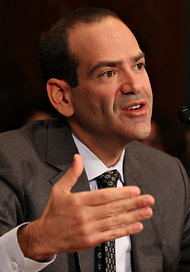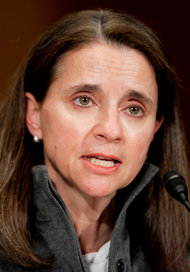
Simon Johnson is the Ronald A. Kurtz Professor of Entrepreneurship at the M.I.T. Sloan School of Management and co-author of “White House Burning: The Founding Fathers, Our National Debt, and Why It Matters to You.”
The Obama administration is floating the idea that Mary J. Miller, under secretary for domestic finance at the Treasury Department, could become its nominee to lead the Securities and Exchange Commission. Ms. Miller, a longtime executive in the mutual funds industry, has served in the Treasury under Timothy Geithner since February 2010.
Today’s Economist
Perspectives from expert contributors.
Ms. Miller represents the financial sector’s preferred approach to financial reform — some talk but very little by way of serious effort. She has no time for people who are serious about making the financial system safer. And there is no willingness to really face down powerful people on Wall Street.
Her potential candidacy faces three major obstacles: Neil Barofsky, money market funds and the new momentum for reform.
 Mark Wilson/Getty Images Neil Barofsky, above, former inspector general for the Troubled Assets Relief Program, and Mary J. Miller, below, a Treasury under secretary, possible candidates to head the Securities and Exchange Commission, have sharply divergent views on tough regulation.
Mark Wilson/Getty Images Neil Barofsky, above, former inspector general for the Troubled Assets Relief Program, and Mary J. Miller, below, a Treasury under secretary, possible candidates to head the Securities and Exchange Commission, have sharply divergent views on tough regulation. Andrew Harrer/Bloomberg News
Andrew Harrer/Bloomberg News
Mr. Barofsky is the most important obstacle, because as soon as you think about him you see an instantly plausible chairman for the S.E.C. The former special inspector general for the Troubled Assets Relief Program, or TARP, he is an experienced prosecutor who understands complex financial fraud. For example, he brought Refco Inc. executives and their legal advisers to justice in the mid-2000s (Refco was a commodities giant where top people engaged in accounting fraud). And he’s tough — he took on Colombian drug traffickers early in his career.
Most recently, he confronted Mr. Geithner over how TARP was carried out — pushing for answers on why bailout terms were so favorable for big banks and so unfavorable for everyone else. He also pursued a number of securities fraud cases, including one involving Colonial Bank, which illegally obtained more than half a billion dollars from TARP. Mr. Barofsky’s office stopped that fraud in its tracks and eventually obtained one of the few high-level convictions resulting from the financial crisis.
Mr. Barofsky’s account is published in his highly readable book, “Bailout: An Inside Account of How Washington Abandoned Main Street While Rescuing Wall Street.” Mr. Barofsky understands as much about finance as anyone in the industry, and no one would ever think he was captured by the worldview of big banks.
Mr. Barofsky is a lifelong Democrat who has enjoyed bipartisan support in Congress. Since I suggested Mr. Barofsky’s name in a post last week, there has been an outpouring of support. A petition that Credo Action has put online urging President Obama to appoint an S.E.C. chairman who will hold Wall Street accountable, and naming Mr. Barofsky as a worthy choice, had more than 35,000 signatures by Wednesday morning.
The petition also recommends former Senator Ted Kaufman of Delaware and Dennis Kelleher of Better Markets — both of whom I endorsed here last week — and it expresses support for Sheila Bair, who would be terrific for the job (in a separate column last week, I said she was one of five people who deserve serious consideration to be Treasury secretary).
The White House does not like to take public suggestions of names for prominent positions; the Washington way is to do everything behind closed doors. And Mr. Barofsky is not popular with Mr. Geithner, precisely because he has stood up to authority for all the right reasons.
“Barofsky is exactly what the S.E.C. needs to restore its tattered reputation as a guardian of the capital markets,” said Matt Stoller, a fellow at the Roosevelt Institute.
Still, considering Mr. Barofsky as a potential nominee makes the case for Ms. Miller look very weak.
She has no experience as a regulator or as an enforcer of the law. She has never worked on securities fraud. And she has no track record of standing up to powerful vested interests; in fact, she helped push the recent JOBS Act, which greatly undermines the protections available to investors. In addition, her work experience is entirely within the mutual fund industry — 26 years at T. Rowe Price. And a major agenda item now for the S.E.C. is mutual funds and how to make them less vulnerable to the kind of runs that occurred in September 2008. (For a primer, please see my recent column for Yahoo Finance.)
The mutual fund industry does not want reform, and it worked long and hard to keep Mary Schapiro, the departing S.E.C. chairwoman, from pushing forward some sensible ideas. After outside pressure was brought to bear, including by Ms. Bair’s Systemic Risk Council (of which I am a member), there are signs that the S.E.C. will finally at least issue some proposed changes for public comment.
I do not know where Ms. Miller stands on money-market reform; indeed, from her public remarks it is very hard to know precisely where she is on any reform issue. It would be most unfortunate to put her in at the S.E.C. precisely when the mutual fund industry is about to come in for some serious scrutiny. The optics, as they say in Washington, would not be good.
More broadly, there is a new push for financial reform — even from people who are close to Wall Street. In a wave of speeches and other statements (some you have seen and some you will see soon), voices are being raised against the too-big-to-fail approach and related causes of financial fragility. In particular, a speech last month by Daniel K. Tarullo, a governor of the Federal Reserve, seems to have released a great deal of pent-up creative thinking within the official sector.
Size caps for big banks are definitely on the drawing board, at least along the lines that Mr. Tarullo identified, which would limit nondeposit liabilities at any one institution relative to the size of our economy.
Given this momentum for responsible reform, does President Obama really want to appoint a financial services executive — with a nonexistent or weak track record on reform — to a prominent public policy and enforcement position?
As Steven Ramirez has pointed out, Big Finance went all in for Mitt Romney and against Senator Sherrod Brown of Ohio and Elizabeth Warren, elected to the Senate in Massachusetts. This was a comprehensive electoral defeat for Wall Street; whenever its behavior was at stake, people voted for change. And the contributions of the Wall Street community did not seem to produce the outcomes it wanted.
There is a view in Washington that politicians need Wall Street and its money — to start campaigns, to provide a wall of financing at critical moments and to help create a generous endowment for post-presidential activities. Without a doubt, this has been the pattern in the past.
But in this big country there are many diverse business sectors — and lots of people willing to give money without asking for special-interest favors.
Choosing a new chairman of the S.E.C. is the perfect time for President Obama to decide whether, despite everything, to go for the status quo — which brought us to our current economic predicament — and nominate Ms. Miller for the S.E.C. Or does he really want effective change? In that case, he should nominate Mr. Barofsky or someone who can match his stellar qualifications.
Article source: http://economix.blogs.nytimes.com/2012/11/22/mary-miller-vs-neil-barofsky-for-the-s-e-c/?partner=rss&emc=rss